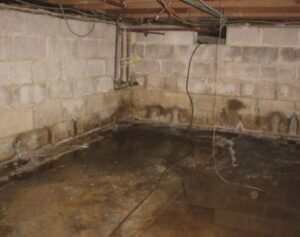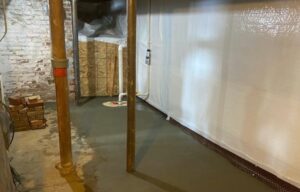Basements, whether used for storage, living spaces, or other purposes, are prone to moisture problems. Water infiltration can lead to a host of issues, including structural damage, mold growth, and the loss of valuable items. Therefore, basement waterproofing is an essential step for homeowners looking to protect their property. This comprehensive guide delves into the various aspects of basement waterproofing, from identifying issues to implementing effective solutions.
Understanding the Causes of Basement Moisture
Before diving into waterproofing methods, it’s crucial to understand the common causes of basement moisture. Identifying the source of the problem is the first step in choosing the right solution.
- Hydrostatic Pressure: Water in the soil surrounding the foundation can exert pressure on basement walls, causing water to seep through cracks and joints. This pressure increases during heavy rains or when the water table rises.
- Poor Drainage: Inadequate drainage systems, such as clogged gutters or improper grading, can direct water towards the foundation rather than away from it.
- Foundation Cracks: Cracks in the foundation walls or floor can allow water to enter the basement. These cracks can result from settling, shifting soil, or other structural issues.
- Condensation: High humidity levels within the basement can lead to condensation on walls and floors, creating a damp environment conducive to mold growth.
Signs of Basement Moisture Problems
Recognizing the signs of moisture problems early can prevent extensive damage and costly repairs. Look out for the following indicators:
- Damp or Musty Odor: Persistent damp smells can indicate the presence of moisture and potential mold growth.
- Visible Water: Puddles, wet spots, or water stains on walls and floors are clear signs of water infiltration.
- Efflorescence: White, powdery deposits on walls can indicate water passing through masonry and evaporating, leaving behind mineral deposits.
- Mold and Mildew: Black, green, or white growth on surfaces points to mold and mildew, both of which thrive in damp conditions.
- Peeling Paint or Wallpaper: Moisture can cause paint to blister and wallpaper to peel away from the walls.
Basement Waterproofing Methods
Effective basement waterproofing requires a combination of interior and exterior solutions. Here are some of the most common methods:
Interior Waterproofing Solutions
- Sealants and Epoxy Injections: Cracks and joints can be sealed using waterproof sealants or epoxy injections. These materials fill the gaps and prevent water from seeping through.
- Interior Drainage Systems: An interior drainage system, such as a French drain or a sump pump, can collect and remove water that enters the basement. These systems are installed along the perimeter of the basement floor and direct water to a sump pit, where it is pumped out.
- Waterproof Coatings: Applying waterproof coatings to basement walls and floors can create a barrier that prevents moisture from penetrating the surfaces. These coatings are typically applied as a liquid and cure to form a durable, waterproof layer.
- Dehumidifiers: Installing a dehumidifier can help control humidity levels within the basement, reducing the likelihood of condensation and mold growth.
Exterior Waterproofing Solutions
- Excavation and Waterproofing: This involves excavating the soil around the foundation to expose the basement walls. A waterproof membrane is then applied to the exterior walls, followed by a layer of drainage board and backfill. This method is highly effective but also the most expensive and labor-intensive.
- Proper Grading: Ensuring that the ground slopes away from the foundation can help direct water away from the basement. This can be achieved by adding soil to create a positive slope.
- Gutter and Downspout Maintenance: Clean and well-maintained gutters and downspouts are essential for directing water away from the foundation. Extensions can be added to downspouts to ensure water is discharged at a safe distance from the house.
- Exterior Drainage Systems: Installing exterior drainage systems, such as French drains or curtain drains, can help manage groundwater and prevent it from reaching the foundation. These systems are installed around the perimeter of the house and work by collecting and redirecting water away from the foundation.
Professional vs. DIY Basement Waterproofing
While some waterproofing solutions can be implemented by homeowners, others require the expertise of a professional. Here’s a breakdown of when to tackle the job yourself and when to call in the pros:
DIY Waterproofing
- Sealing Small Cracks: Small cracks in the foundation can often be sealed with epoxy or waterproof sealant, a task that most homeowners can handle.
- Installing a Dehumidifier: Adding a dehumidifier to control basement humidity is a simple and effective DIY solution.
- Gutter Maintenance: Regularly cleaning and maintaining gutters and downspouts is an essential task that homeowners can do themselves.
Professional Waterproofing
- Major Foundation Repairs: Significant cracks or structural issues require the expertise of a professional to ensure proper repair and prevent further damage.
- Exterior Excavation: Excavating around the foundation and applying waterproof membranes is a complex and labor-intensive job best left to professionals.
- Installing Drainage Systems: While some interior drainage systems can be installed by handy homeowners, exterior drainage systems and sump pumps often require professional installation for optimal performance.
Costs of Basement Waterproofing
The cost of basement waterproofing can vary widely depending on the extent of the problem and the chosen solutions. Here’s a general idea of what to expect:
- Sealants and Epoxy Injections: $500 – $2,000
- Interior Drainage Systems: $2,000 – $6,000
- Waterproof Coatings: $500 – $3,000
- Dehumidifiers: $200 – $1,500
- Exterior Excavation and Waterproofing: $8,000 – $15,000
- Gutter and Downspout Maintenance: $100 – $300
- Exterior Drainage Systems: $1,000 – $5,000
Maintenance and Long-Term Solutions
Once your basement is waterproofed, regular maintenance is essential to ensure the effectiveness of the solutions and prevent future issues. Here are some maintenance tips:
- Regular Inspections: Periodically inspect your basement for signs of moisture, cracks, and mold. Early detection can help prevent more significant problems.
- Maintain Gutters and Downspouts: Keep gutters clean and ensure downspouts are directing water away from the foundation.
- Control Humidity: Use a dehumidifier to maintain appropriate humidity levels in the basement, especially during the humid months.
- Address Landscaping: Ensure that the landscaping around your home promotes proper drainage and does not direct water towards the foundation.
Basement waterproofing is a critical investment for homeowners looking to protect their property from water damage and maintain a healthy living environment. By understanding the causes of basement moisture, recognizing the signs of problems, and implementing effective interior and exterior solutions, you can ensure that your basement remains dry and functional. Whether you choose to tackle the job yourself or hire a professional, the key is to act promptly and proactively to prevent water infiltration and its associated problems.
Contact the Professionals at Seal-Tite Basement Waterproofing Today! 540-992-1144

Seal-tite Basement Waterproofing Co. is a full service basement environment contractor. We carry an A+ Better Business Bureau rating. We repaired over 40,000 homes and structures in Virginia, West Virginia, Tennessee, and North Carolina. We are fully insured and licensed. We have worked in all types of locations, including residential and commercial locations, government agencies, colleges, hospitals, churches, and condo associations.
Seal-tite® offers a lifetime transferable warranty. We carry a Class A Contractor’s License and we are fully insured. Our satisfied customers range from government agencies to businesses, hospitals, colleges, churches, and thousands of homeowners. Your home is probably the single largest investment you will make in your lifetime. Don’t wait, call Seal-tite® to help make your home dry, safe and livable.


